

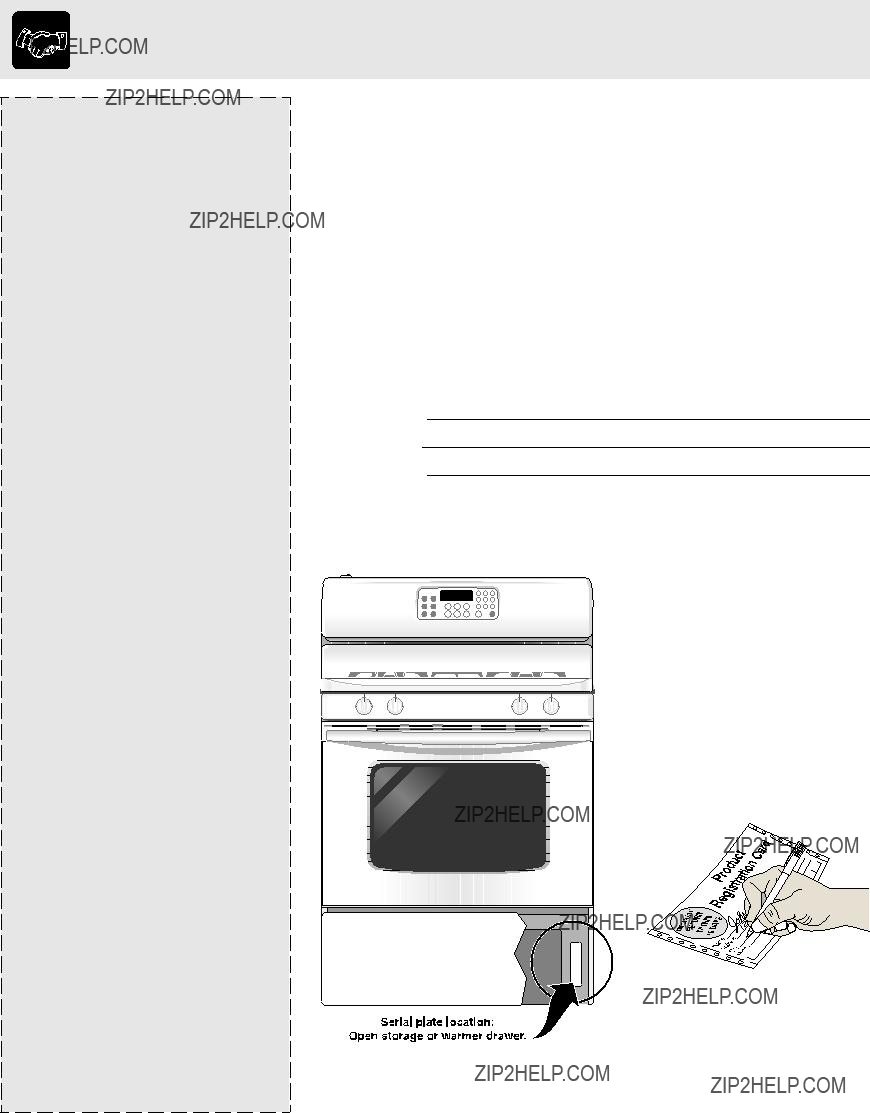
Welcome & Congratulations
Questions?
(United States)
(Canada)
Please attach sales receipt here for future reference.
Congratulations on your purchase of a new range! At Electrolux Home Products, we are very proud of our product and are completely committed to providing you with the best service possible. Your satisfaction is our number one priority.
We know you???ll enjoy your new range and Thank You for choosing our product. We hope you consider us for future purchases.
PLEASE CAREFULLY READ AND SAVE THESE INSTRUCTIONS
This Use & Care Manual provides specific operating instructions for your model. Use your range only as instructed in this manual. These instructions are not meant to cover every possible condition and situation that may occur. Common sense and caution must be practiced when installing, operating and maintaining any appliance.
Please record your model and serial numbers below for future reference.
Model Number:
Serial Number:
Purchase Date:
Product
Registration
Register Your Product
The
??2003 Electrolux Home Products, Inc. All rights reserved
This Use & Care Manual contains general operating instructions for your range and feature information for several models. Your range may not have all the described features. The graphics shown are representative. The graphics on your range may not look exactly like those shown.
2
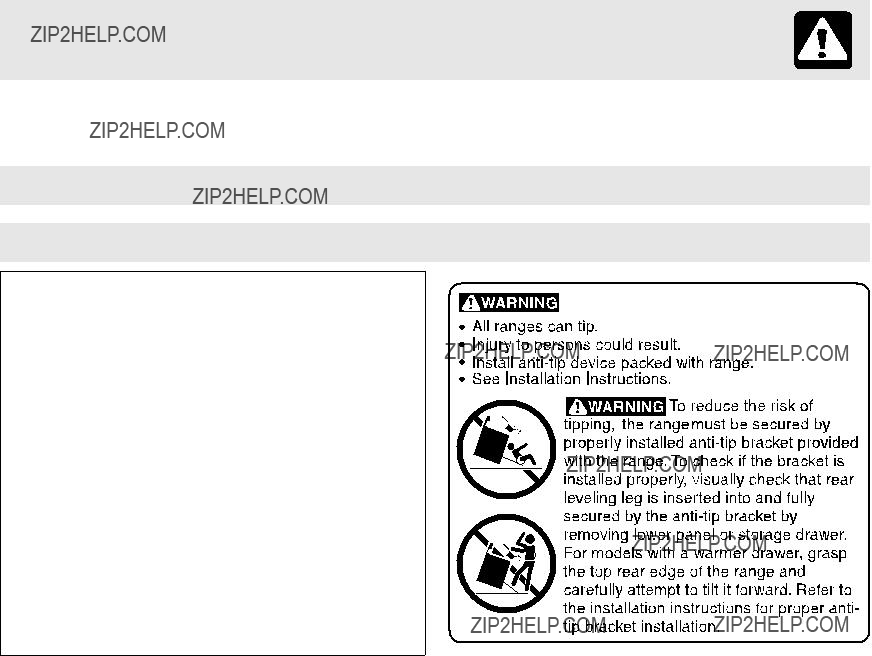
Important Safety Instructions
Read all instructions before using this appliance.
Save these instructions for future reference.
This manual contains important safety symbols and instructions. Please pay attention to these symbols and follow all instructions given.
 This symbol will help alert you to situations that may cause serious bodily harm, death or property damage.
This symbol will help alert you to situations that may cause serious bodily harm, death or property damage.
 This symbol will help alert you to situations that may cause bodily injury or property damage.
This symbol will help alert you to situations that may cause bodily injury or property damage.
 If the information in this manual is not followed exactly, a fire or explosion may result causing property damage, personal injury or death.
If the information in this manual is not followed exactly, a fire or explosion may result causing property damage, personal injury or death.
FOR YOUR SAFETY:
???Do not store or use gasoline or other flammable vapors and liquids in the vicinity of this or any other appliance.
???WHAT TO DO IF YOU SMELL GAS:
???Do not try to light any appliance.
???Do not touch any electrical switch; do not use any phone in your building.
???Immediately call your gas supplier from a neighbor's phone. Follow the gas supplier's instructions.
???If you cannot reach your gas supplier, call the fire department.
???Installation and service must be performed by a qualified installer, servicer or the gas supplier.
???Remove all tape and packaging before using the range.
Destroy the carton and plastic bags after unpacking the range. Never allow children to play with packaging material.
???Proper
Ask your dealer to recommend a qualified technician and an authorized repair service. Know how to disconnect the power to the range at the circuit breaker or fuse box in case of an emergency.
???User
All other servicing should be done only by a qualified technician, This may reduce the risk of personal injury and damage to the range.
???Never modify or alter the construction of a range by removing leveling legs, panels, wire covers,
 Stepping, leaning or sitting on the doors or drawers of this range can result in serious injuries and also cause damage to the range. Do not allow children to climb or play around the range. The weight of a child on an open door may cause the range to tip, resulting in serious burns or other injury.
Stepping, leaning or sitting on the doors or drawers of this range can result in serious injuries and also cause damage to the range. Do not allow children to climb or play around the range. The weight of a child on an open door may cause the range to tip, resulting in serious burns or other injury.
 Do not use the oven or warmer drawer (if equipped) for storage.
Do not use the oven or warmer drawer (if equipped) for storage.
 Do not store items of interest to children in the cabinets above a range or on the backguard of a range.
Do not store items of interest to children in the cabinets above a range or on the backguard of a range.
Children climbing on the range to reach items could be seriously injured.
 Never Use Your Appliance for Warming or Heating the Room.
Never Use Your Appliance for Warming or Heating the Room.
???Storage in or on
3

Important Safety Instructions
???Do Not Leave Children
They should never be allowed to sit or stand on any part of the appliance.
???DO NOT TOUCH SURFACE BURNERS, AREAS NEAR
THESE BURNERS, OVEN BURNERS OR INTERIOR SURFACES OF THE OVEN. Both surface and oven burners may be hot even though flames are not visible. Areas near surface burners may become hot enough to cause burns. During and after use, do not touch, or let clothing or other flammable materials touch these areas until they have had sufficient time to cool. Among these areas are the cook top, surfaces facing the cook top, the oven vent openings and surfaces near these openings, oven door and window.
???Wear Proper
???Do Not Use Water or Flour on Grease
???When heating fat or grease, watch it closely. Fat or grease may catch fire if allowed to become too hot.
???Use Only Dry
???Do Not Heat Unopened Food
???Remove the oven door from any unused range if it is to be stored or discarded.
IMPORTANT INSTRUCTIONS FOR USING
YOUR COOKTOP
 Use Proper Flame
Use Proper Flame
???Know which knob controls each surface burner. Place a pan of food on the burner before turning it on, and turn the burner off before removing the pan.
???Always turn knob to the full LITE position when igniting top burners. Visually check that burner has lit. Then adjust the flame so it does not extend beyond the edge of the utensil.
???Utensil Handles Should Be Turned Inward and Not Extend Over Adjacent Surface
???Never Leave Surface Burners Unattended at High Heat
???Protective
???Glazed Cooking
IMPORTANT INSTRUCTIONS FOR USING
YOUR OVEN
???Use Care When Opening Oven Door or Warmer Drawer???
Stand to the side of the range when opening the door of a hot oven. Let hot air or steam escape before you remove or replace food in the oven.
???Keep Oven Vent Ducts Unobstructed. The oven vent is located below the backguard. Touching the surfaces in this area when the oven is operating may cause severe burns. Also, do not place plastic or
???Placement of Oven Racks. Always place oven racks in desired location while oven is cool. If rack must be moved while oven is hot use extreme caution. Use potholders and grasp the rack with both hands to reposition. Do not let potholders contact the hot heating elements in the oven. Remove all utensils from the rack before moving.
???Do not use the broiler pan without its insert. The broiler pan and its insert allow dripping fat to drain and be kept away from the high heat of the broiler.
???Do not cover the broiler insert with aluminum foil. Exposed fat and grease could ignite.
???Cold temperatures can damage the electronic control. When using the appliance for the first time, or when the appliance has not been used for an extended period of time, be certain the unit has been in temperatures above 32??F (0??C) for at least 3 hours before turning on the power to the appliance.
IMPORTANT INSTRUCTIONS FOR CLEANING
YOUR RANGE
???Clean the range regularly to keep all parts free of grease that could catch fire. Pay particular attention to the area in and around each surface burner. Do not allow grease to accumulate. Refer to the range manufacturer???s instructions for cleaning.
???Kitchen cleaners and
SELF CLEANING OVENS
???Clean in the
???Do Not Use Oven
???Do Not Clean Door
4

Important Safety Instructions
GROUNDING INSTRUCTIONS
See the INSTALLATION INSTRUCTIONS packaged with this range for complete installation and grounding instructions.
(electric ignition models only)
 Avoid fire hazard or electrical shock. Do not use an adapter plug, an extension cord, or remove grounding prong from electrical power cord. Failure to follow this warning can cause serious injury, fire or death.
Avoid fire hazard or electrical shock. Do not use an adapter plug, an extension cord, or remove grounding prong from electrical power cord. Failure to follow this warning can cause serious injury, fire or death.
 This appliance is equipped with a
This appliance is equipped with a
For personal safety, the range must be properly grounded. For maximum safety, the power cord must be plugged into an electrical outlet that is correctly polarized and properly grounded.
If a
IMPORTANT SAFETY NOTICE
The California Safe Drinking Water and Toxic Enforcement Act requires the Governor of California to publish a list of substances known to the state to cause cancer, birth defects or other reproductive harm, and requires businesses to warn customers of potential exposure to such substances.
Conversion to Liquified Petroleum (L.P.) Gas
The range is designed to allow for conversion to Liquified Petroleum (L.P.) Gas. Contact your qualified appliance distributor to obtain the proper L.P. Kit. Follow the L.P. Kit Installation Instructions carefully.
READ AND SAVE THESE INSTRUCTIONS
5
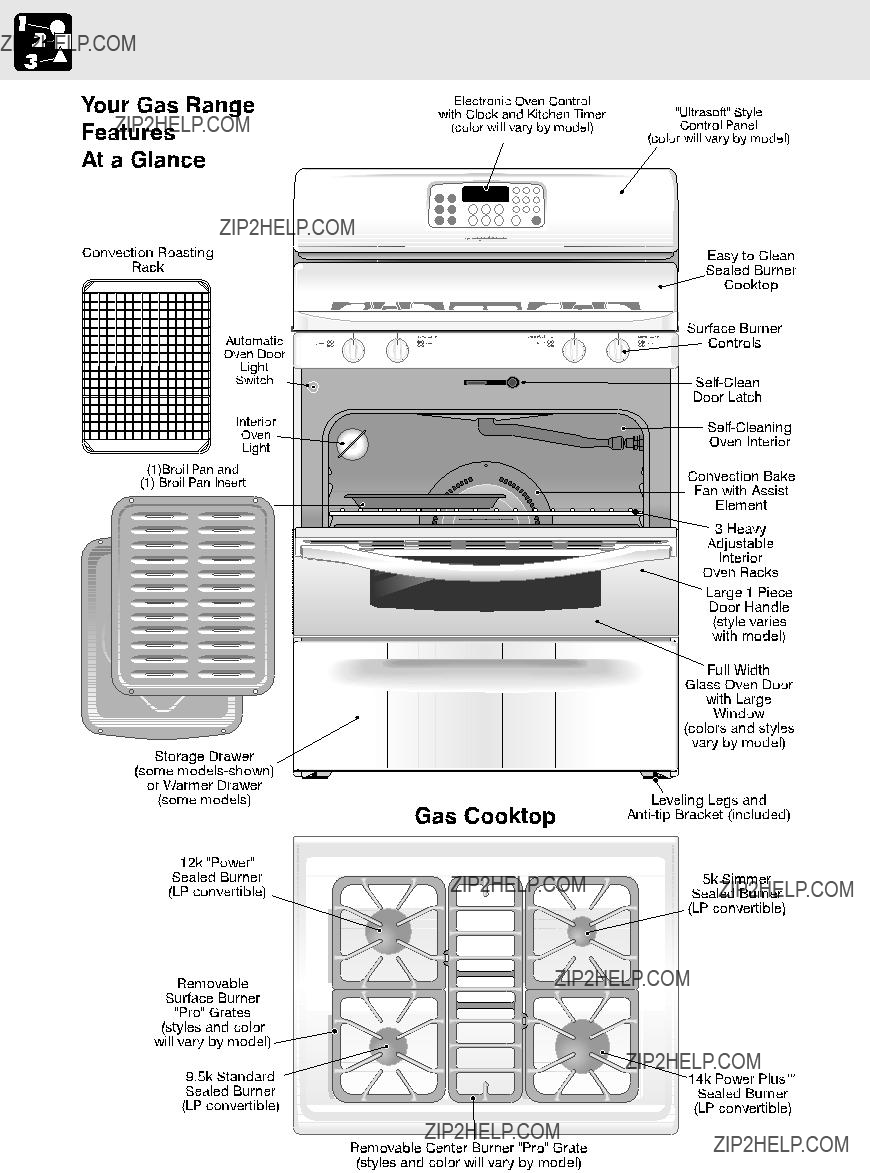
Features At A Glance
6
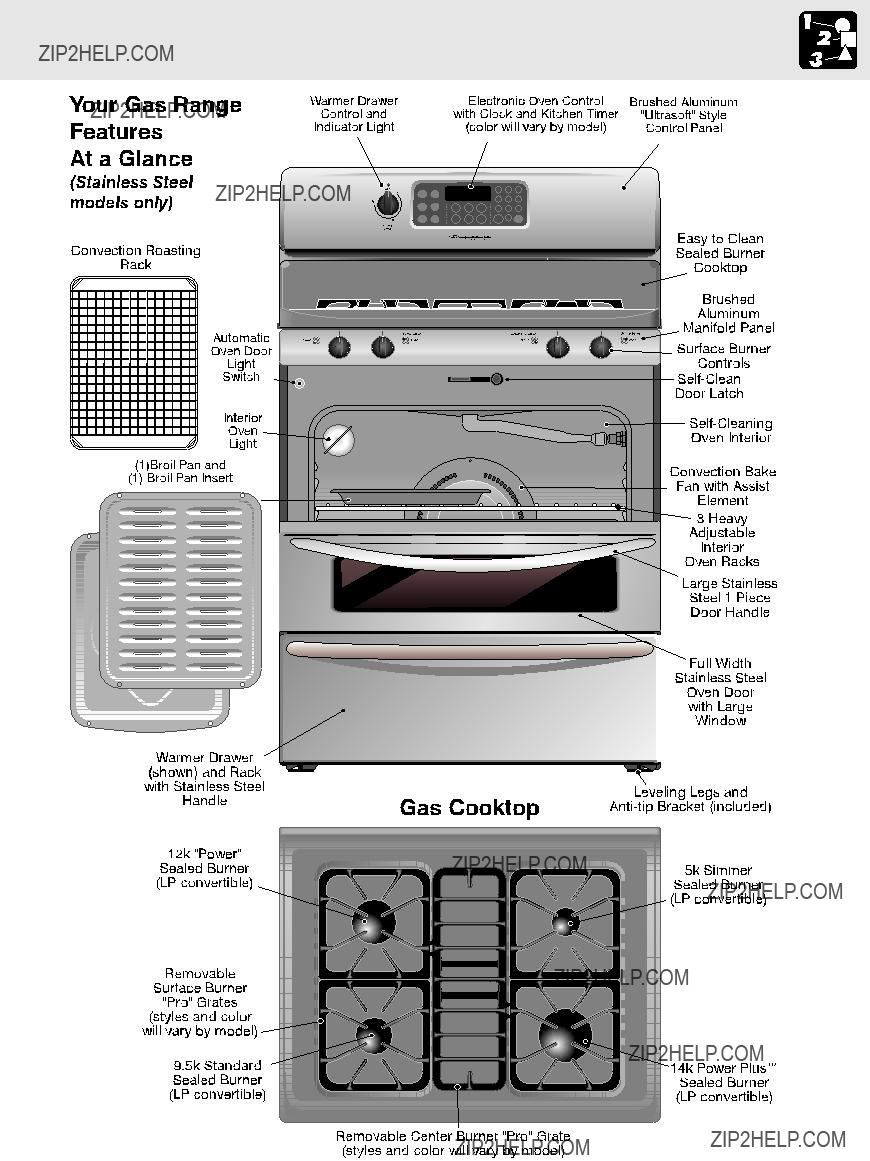
Features At A Glance
7

Setting Surface Controls
Sizes of the Surface Gas Burners
Figure 2
Figure 3
Figure 1
Your gas range was supplied with 4 different surface gas burners; a "SIMMER" Burner (5,000 BTU), a STANDARD burner (9,500 BTU), a "POWER" Burner (12,000 BTU) and a POWER PLUS??? Burner (14,000 BTU). When setting up the gas range for the first time, make sure that the correct Burner Heads, Burner Caps and Burner Grates are correctly (See Fig. 1).
Assembly of the Surface Burner Heads, Burner Caps and Burner Grates:
It is very important to makes sure that all of the Surface Burner Heads, Surface Burner Caps and Surface Burner Grates are installed correctly and in the correct locations.
1.Place all 4 Burner Heads in the correct locations (See Fig. 1). Make sure that the correct Burner Head is placed with the corresponding Orifice Holder and that the Electrode is located properly in the slot provided of each Burner Head (See Fig. 2). Proper Burner Head placement insures that each Burner will have the correct spark required for gas ignition.
2.Place the correct Burner Caps at each of the burner locations. Each of the 4 Burner Heads MUST have a Burner Cap installed to insure proper ignition and gas flame size before placing the Burner Grates (See Fig. 2).
3.Place the 4 cast iron surface Burner Grates supplied with the range. After the surface grates been installed place the center grate between the four grates and be sure to interlock the grates correctly (See Fig. 3).
REMEMBER ??? DO NOT ALLOW SPILLS, FOOD, CLEANING AGENTS OR
ANY OTHER MATERIAL TO ENTER THE GAS ORIFICE HOLDER OPENING. Always keep the Burner Caps and Burner Heads in place whenever the surface burners are in use.
8
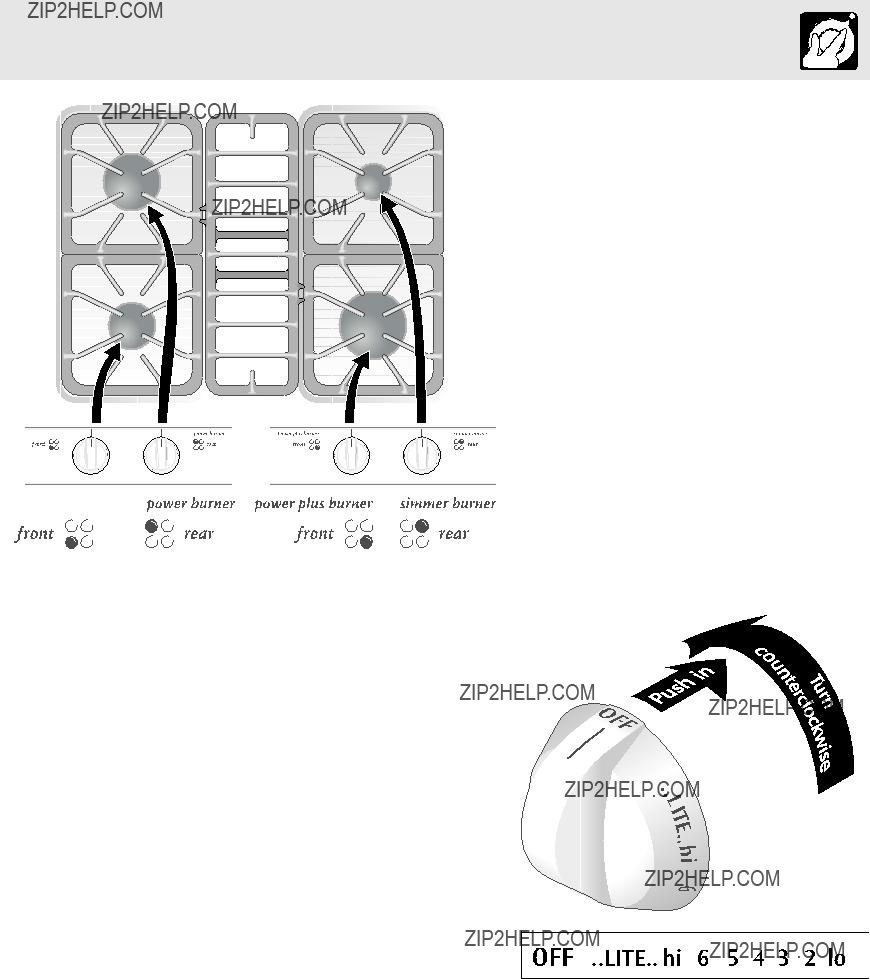
Setting Surface Controls
Operating the Gas Surface Burner Controls:
1.Place cooking utensil on surface burner.
2.Push the surface control knob in and turn counterclockwise out of the OFF position (See Fig. 2).
3.Release the knob and rotate to the LITE position. Note: All four electronic surface ignitors will spark at the same time. However, only the burner you are turning on will ignite.
4.Visually check that the burner has a flame.
5.Turn the control knob counterclockwise to the desired flame size. The control knobs do not have to be set at a particular setting. Use the knob indicator settings to adjust the flame as needed. DO NOT cook with the surface control knob in the LITE position. (The electronic ignitor will continue to spark if the knob is left in the LITE position.)
 Do not place plastic items such as salt and pepper shakers, spoon holders or plastic wrappings on top of the range when it is in use. These items could melt or ignite. Potholders, towels or wood spoons could catch fire if placed too close to a flame.
Do not place plastic items such as salt and pepper shakers, spoon holders or plastic wrappings on top of the range when it is in use. These items could melt or ignite. Potholders, towels or wood spoons could catch fire if placed too close to a flame.
Control Locations of the Gas Surface
Burners
Your range is equipped with gas surface burners with 4 different BTU ratings. The ability to heat food quicker and in larger volumes increases as the burner size increases.
The smaller SIMMER burner is best used for simmering delicate sauces, etc. This burner is located at the right rear burner position on the cooktop (See Fig. 1).
The STANDARD size burner can be used for most surface cooking needs. This burner is located at the left front burner position on the cooktop (See Fig. 1).
The larger 2 POWER and POWER PLUS??? burners are best used for bringing large quantities of liquid rapidly up to temperature or when preparing larger quantities of food. The two
POWER and POWER PLUS??? Burners are located at the left rear and right front burner (See positions on the cooktop as shown in Fig. 1).
Figure 2
9
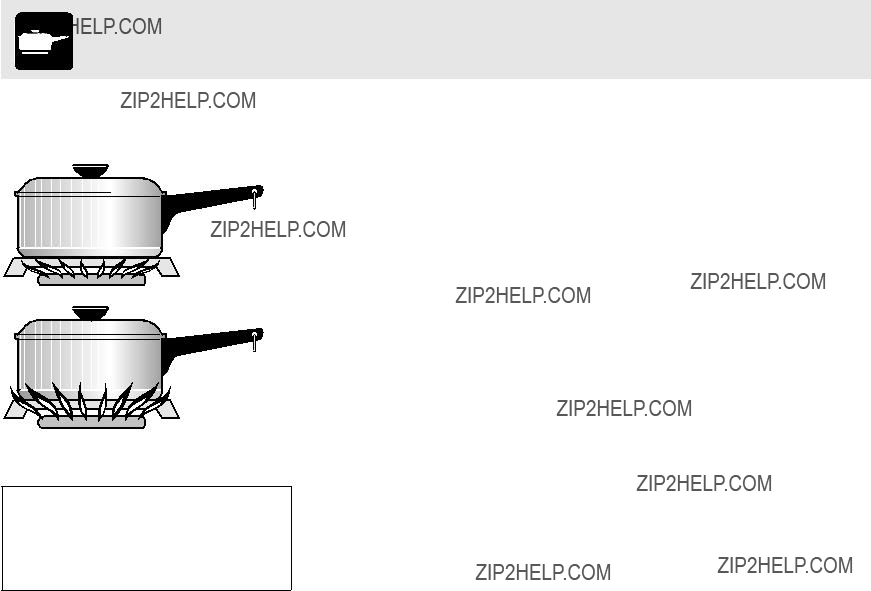
Surface Cooking
Setting Proper Surface Burner Flame Size
PROPER
FLAME
SIZE
IMPROPER
FLAME
SIZE
Never extend the flame beyond the outer edge of the utensil. A higher flame simply wastes heat and energy, and increases the risk of being burned by the gas flame.
For most cooking - start on the highest control setting and then turn to a lower one to complete the process. Use the recommendations below as a guide for determining proper flame size for various types of cooking. The size and type of utensil used and the amount of food being cooked will influence the setting needed.
For deep fat frying - use a thermometer and adjust the surface control knob accordingly. If the fat is too cool, the food will absorb the fat and be greasy. If the fat is too hot, the food will brown so quickly that the center will be undercooked. Do not attempt to deep fat fry too much food at once as the food will neither brown nor cook properly.
*Note: Settings are based on using
10
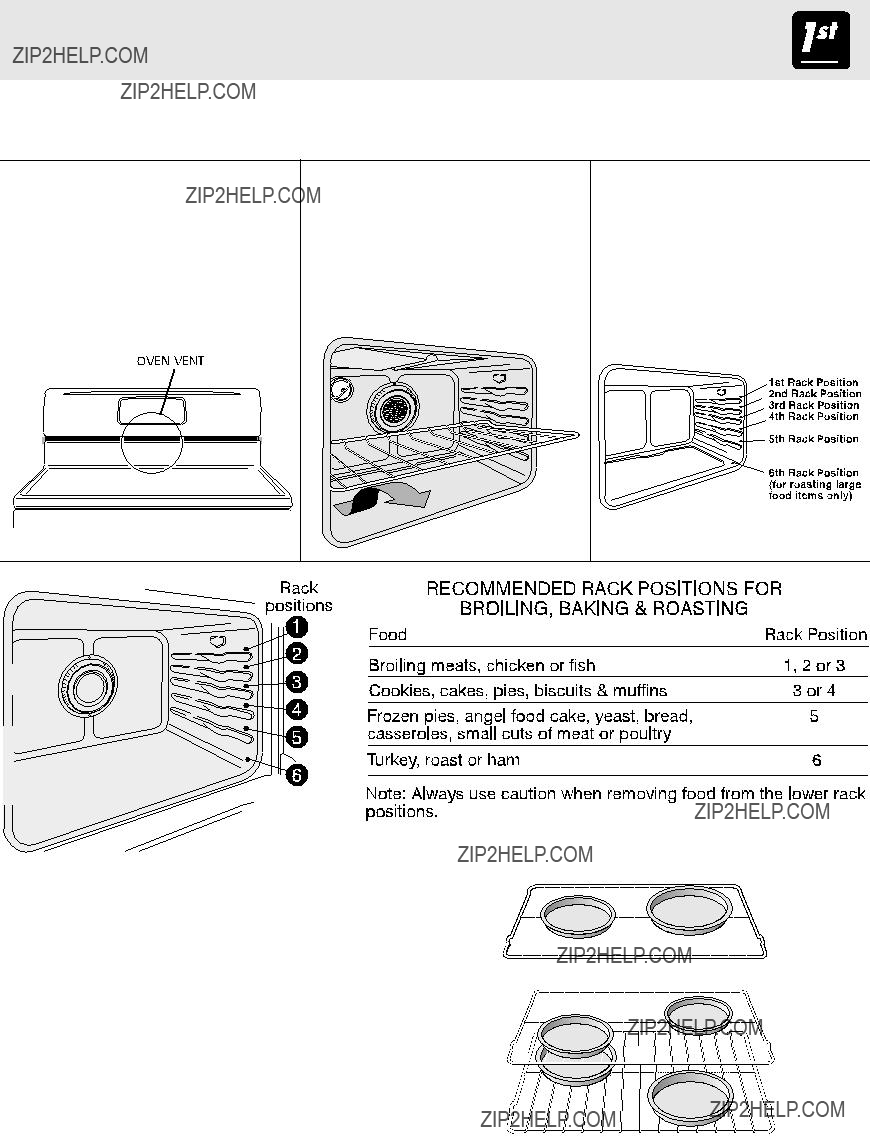
Before Setting Oven Controls
Arranging the Oven Racks
ALWAYS ARRANGE OVEN RACKS WHEN THE OVEN IS COOL (PRIOR TO OPERATING THE OVEN). Always use oven mitts when the oven is hot.
Oven Vent Location
The oven vent is located below the backguard. When the oven is on, hot air is released through the vents. This venting is necessary for proper air circulation in the oven and good baking results.
Removing and Replacing Oven
Racks
To remove, pull the rack forward until it stops. Lift up front of rack and slide out. To replace, fit the rack onto the guides on the oven walls. Tilt the front of the rack upward and slide the rack back into place.
Arranging Oven Racks
To bake on a single rack, place the rack in position 4. To bake on 2 racks, place the racks in positions 2 and 4. To bake on 3 racks, place the racks in positions 1, 3 and 5.
Air Circulation in the Oven
If using 1 rack, place in center of oven. If using multiple racks, stagger cookware as shown.
1 Oven Rack
For best air circulation and baking results allow
Multiple Oven Racks
11

Setting Warming Drawer Controls
(some models)
Arranging Warming Drawer Rack Positions
The rack can be used in 2 ways:
???In the upright position to allow low profile food items to be placed both under and on top of the rack (for example, rolls or biscuits on top of the rack and a casserole dish underneath).
???In the downward position to allow you to place light weight food items and empty cookware (for example, rolls or pastries and dinner plates) on the rack.
Set the Warming Drawer rack in either position as shown below (Fig. 1).
Figure 1
To Operate the Warming Drawer
The purpose of the Warming Drawer is to keep hot cooked foods at serving temperature. Always start with hot food. It is not recommended to heat cold food in the Warming Drawer.
All food placed in the Warming Drawer should be covered with a lid or aluminum foil to maintain quality. Do not use plastic wrap to cover food. Plastic may melt onto the drawer and be very difficult to clean. Use only utensils and cookware recommended for oven use in the Warming Drawer.
To Set the Warming Drawer Control
The control is used to select the temperature of the Warming Drawer. It is located on the control panel. To set the control, push in and turn the knob to the desired setting. The temperatures are approximate and are designated by HI (high), MED (medium) and LO (low). To set the Warming Drawer control:
1.Turn the knob to select the desired temperature setting.
2.For best results, preheat the drawer before adding food. An empty drawer will preheat in approximately 15 minutes.
3.When done, turn the control to OFF.
Warming Drawer Temperature Selection
Recommended Warming Drawer food settings are shown in Figure 3. If a particular food is not listed, start with the MED setting. If more crispness is desired, remove the lid or aluminum foil from the food. Most foods can be kept at serving temperatures on the MED setting. When a combination of foods are to be kept warm (for example, a meat with 2 vegetables and rolls) use the HI setting. To avoid heat loss, do not open the Warming Drawer while in use.
Warming Drawer Indicator Light
The Warming Drawer indicator light is located above the Warming Drawer control knob (See Fig. 2). It turns on when the control is set, and stays on until the control is turned off. The warmer drawer will not operate during the self- clean cycle.
Figure 2
Warming Drawer Recommended
Food Settings Table
 Always use pot holders or oven mitts when removing food from the warmer drawer as cookware and plates will be hot and you can be burned.
Always use pot holders or oven mitts when removing food from the warmer drawer as cookware and plates will be hot and you can be burned.
12

Control Pad Features
READ THE INSTRUCTIONS CAREFULLY BEFORE USING THE OVEN. For satisfactory use of your oven, become
familiar with the various features and functions of the oven as described below. Detailed instructions for each feature
and function follow later in this Use & Care Manual.
Minimum and Maximum Control Pad
All of the features listed have minimum and maximum time or temperature settings that may be entered into the control. An ENTRY acceptance beep will sound each time a control pad is touched (the Oven Lockout pad is delayed by 3 seconds).
An ENTRY ERROR tone (3 short beeps) will sound if the entry of the temperature or time is below the minimum or above the maximum settings for the feature.
Settings
MAX. TEMP. /TIME
550??F / 288??C 550??F / 288??C
550??F / 288??C
13

Setting Oven Controls
Setting the Clock
The CLOCK  pad is used to set the clock. The clock may be
pad is used to set the clock. The clock may be
set for 12 or 24 hour time of day operation. The clock has been preset at the factory for the 12 hour operation. When the range is first plugged in, or when the power supply to the range has been interrupted, the timer in the display will flash with "PF" (power failure, See Fig. 1).
INSTRUCTIONS
To set the clock (example below for 1:30):
1.Press  . "CLO" will appear in the display (Fig. 2).
. "CLO" will appear in the display (Fig. 2).
2.Press 

 pads to set the time of day to 1:30 (Fig.
pads to set the time of day to 1:30 (Fig.
3). "CLO" will appear in the display. Press  . "CLO" will disappear and the clock will start (Fig. 4).
. "CLO" will disappear and the clock will start (Fig. 4).
Changing between 12 or 24 hour time of day display:
1.Press and hold  for 6 seconds (Fig. 3). While holding the pad down, the current time of day will remain and "CLO" will disappear from the display (Fig. 4). CONTINUE holding the pad until the a beep is heard.
for 6 seconds (Fig. 3). While holding the pad down, the current time of day will remain and "CLO" will disappear from the display (Fig. 4). CONTINUE holding the pad until the a beep is heard.
2.The display will show either "12:00" (Fig. 5) or "24:00" (Fig. 6).
3.Press  to switch between the 12 and 24 hour time of day display. The display will show either "12:00" (Fig. 5) or "24:00" (Fig. 6).
to switch between the 12 and 24 hour time of day display. The display will show either "12:00" (Fig. 5) or "24:00" (Fig. 6).
4.Press  to accept the change or press
to accept the change or press  to reject the change.
to reject the change.
5.Reset the correct time as described in To set the Clock above. Please note that if the 24 hour time of day mode was chosen, the clock will now display time from 0:00 through 23:59 hours.
14
PRESS
 for 6 seconds
for 6 seconds
 or
or 
Figure 1
DISPLAY
Figure 2
Figure 3
Figure 4
Figure 5
Figure 6
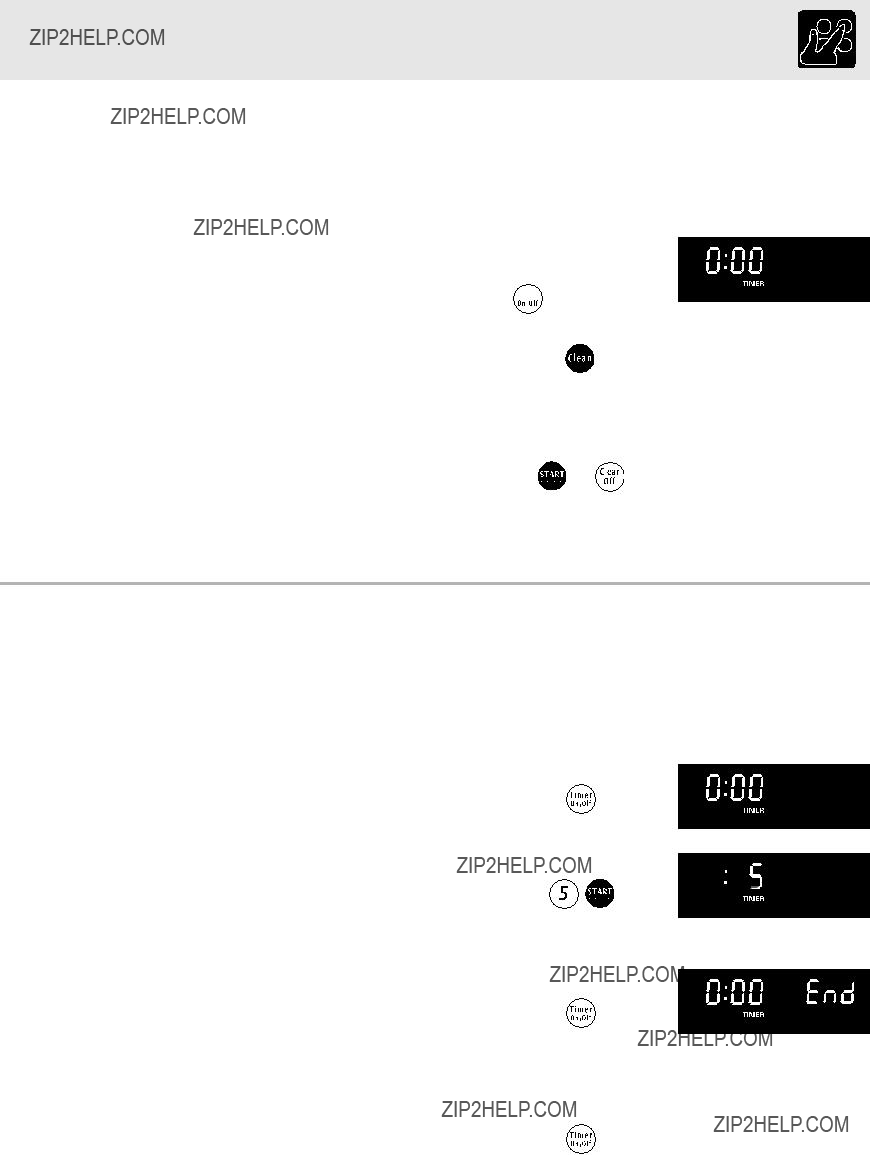
Setting Oven Controls
Setting Continuous Bake or 12 Hour Energy Saving
The KITCHEN TIMER  and CLEAN
and CLEAN  pads control the Continuous Bake or 12 Hour Energy Saving features. The
pads control the Continuous Bake or 12 Hour Energy Saving features. The
oven control has a factory preset
To set the control for Continuous Bake or 12 Hour Energy Saving features:
1.Press and hold  for 7 seconds (Fig.1). ":12" or ":-
for 7 seconds (Fig.1). ":12" or ":-
2.Press  to switch between the 12 Hour Energy Saving and continuous bake features. Note: ":12" in the display indicates the control is set for the 12 Hour Energy Saving mode and ":-
to switch between the 12 Hour Energy Saving and continuous bake features. Note: ":12" in the display indicates the control is set for the 12 Hour Energy Saving mode and ":-
3.Press  to accept the change (Fig. 4; display will return to time of day) or press
to accept the change (Fig. 4; display will return to time of day) or press  to reject the change.
to reject the change.


 for 7 seconds
for 7 seconds
Figure 1
Figure 4
Setting Kitchen Timer
The KITCHEN TIMER  pad controls the Kitchen Timer feature. The Kitchen Timer serves as an extra timer in the
pad controls the Kitchen Timer feature. The Kitchen Timer serves as an extra timer in the
kitchen that will beep when the set time has run out. It does not start or stop cooking. The Kitchen Timer feature can be used during any of the other oven control functions. Refer to the ???Minimum and Maximum Control Pad Settings??? on page 15 for the time amount settings.
To set the Kitchen Timer (example for 5 minutes):
1. Press  . "0:00" will appear and "TIMER" will flash in the display (Fig. 5).
. "0:00" will appear and "TIMER" will flash in the display (Fig. 5).
2.Press the number pads to set the desired time in the display
(example  ). Press
). Press  . The time will begin to count down (Fig. 6) and "TIMER" will appear in the display. Note: If
. The time will begin to count down (Fig. 6) and "TIMER" will appear in the display. Note: If  is not pressed the timer will return to the time of day.
is not pressed the timer will return to the time of day.
3.When the set time has run out, "End" will show in the display
(Fig. 7), and 3 beeps every 60 seconds will sound until  is pressed.
is pressed.
Figure 5
Figure 6
Figure 7
To cancel the Kitchen Timer before the set time has run out:
Press  . The display will return to the time of day.
. The display will return to the time of day.
15

Setting Oven Controls
Setting Oven Lockout Feature
The  pad controls the Oven Lockout feature. The Oven Lockout feature automatically locks the oven door and
pad controls the Oven Lockout feature. The Oven Lockout feature automatically locks the oven door and
prevents the warmer drawer and ESEC Control from being turned on. It does not disable the clock, Kitchen Timer, Warmer Zone or the interior oven lights.
INSTRUCTIONS
To activate the Oven Lockout feature:
1.Press and hold  for three seconds (Fig. 1).
for three seconds (Fig. 1).
2.After 3 seconds the lock icon light (  ) will appear, a beep will sound and "DOOR LOCKED" will flash in the display. Once the oven door is locked the "DOOR LOCKED" indicator will stop flashing and remain on along with the lock icon light.
) will appear, a beep will sound and "DOOR LOCKED" will flash in the display. Once the oven door is locked the "DOOR LOCKED" indicator will stop flashing and remain on along with the lock icon light.
PRESSDISPLAY
 for 3 seconds
for 3 seconds
Figure 1
To reactivate normal oven operation:
completely unlocked and the lock icon light (  ) will clear (See Fig. 2).
) will clear (See Fig. 2).
Figure 2
2. The range is again fully operational.
Setting Temperature Display ??? Fahrenheit or Celsius
The BROIL  and CLEAN
and CLEAN  pads control the Fahrenheit or Celsius
pads control the Fahrenheit or Celsius
temperature display modes. The oven control can be programmed to display temperatures in Fahrenheit or Celsius. The oven has been preset at the factory to display in Fahrenheit.
INSTRUCTIONS
To change display from Fahrenheit to Celsius or Celsius to Fahrenheit:
1.To tell if the display is set for Fahrenheit or Celsius press and hold the  pad. "BROIL", "550??" will appear in the display
pad. "BROIL", "550??" will appear in the display
PRESS
 for 7seconds
for 7seconds
DISPLAY
Figure 3
(See Fig. 3) and continue to HOLD for 7 seconds. A beep will then sound. If "F" appears, the display is set to show temperatures in Fahrenheit (Fig. 4). If "C" appears, the display is set to show temperatures in Celsius (Fig. 5).
2. Press  to switch between Fahrenheit or Celsius display modes. The display will show either "F" (Fig. 4) or "C" (Fig. 5).
to switch between Fahrenheit or Celsius display modes. The display will show either "F" (Fig. 4) or "C" (Fig. 5).
Figure 4
Figure 5
16

Setting Oven Controls
Setting Silent Control Operation
The STOP TIME  and CLEAN
and CLEAN  pads control the Silent Control operation feature. The Silent Control operation
pads control the Silent Control operation feature. The Silent Control operation
feature allows the oven control to be operated without sounds or beeps whenever necessary. If desired the control can be programmed for silent operation and later returned to operating with all the normal sounds and beeps.
To change control from normal sound operation to silent control operation:
1.To tell if your range is set for normal or silent operation press
and hold  for 7 seconds. "DELAY" will appear and flash in the display (Fig. 1). If ":SP" appears (Fig. 2), the control will operate with normal sounds and beeps. If ":-
for 7 seconds. "DELAY" will appear and flash in the display (Fig. 1). If ":SP" appears (Fig. 2), the control will operate with normal sounds and beeps. If ":-
2.Press  to switch between normal sound operation and silent operation mode. The display will show either ":SP" (Fig. 2) or ":-
to switch between normal sound operation and silent operation mode. The display will show either ":SP" (Fig. 2) or ":-
3.Press  to accept the change or press
to accept the change or press  to reject the change.
to reject the change.
Figure 1
 for 7seconds
for 7seconds
Figure 2
Figure 3



 or
or
17

Setting Oven Controls
Setting Preheat
The PREHEAT  pad controls the Preheat feature. The Preheat feature will bring the oven up to temperature and then
pad controls the Preheat feature. The Preheat feature will bring the oven up to temperature and then
indicate when to place the food in the oven. Use this feature when recipes call for preheating. Preheating is not necessary when roasting or cooking casseroles. The oven can be programmed to preheat at any temperature between 170??F to 550??F.
To set the Preheat temperature for 350??F:
1.Arrange the interior oven racks.
2.Press  . "- - - ??" and "BAKE" will appear in the display (Fig. 1).
. "- - - ??" and "BAKE" will appear in the display (Fig. 1).
3.Press 

 . "350??" and "PRE" will appear in the display (Fig. 2).
. "350??" and "PRE" will appear in the display (Fig. 2).
4.Press  . "PRE" and "BAKE" will appear in the display as the oven heats and reaches 350??F (Fig 3).
. "PRE" and "BAKE" will appear in the display as the oven heats and reaches 350??F (Fig 3).
Note: After the oven has reached the desired temperature (this example, 350??F) the control will beep and the "PRE" light will turn off and oven temperature will be displayed (Fig. 4). If the beep was missed, a quick glance at the display with oven temperature showing in the oven display is a good way to check that the oven has already reached the preheat temperature. Once the oven has preheated, PLACE FOOD IN THE OVEN. The "BAKE" light will stay on.
Press  when baking is complete or to cancel the preheat feature.
when baking is complete or to cancel the preheat feature.
Figure 1
Figure 2
Figure 3
Figure 4
To change Preheat temperature while oven is preheating (example changing from 350 to 425??F):
If it is necessary to change the preheat temperature while the oven is preheating to the original temperature:
1.While preheating, press  . "- -
. "- -
2.Enter the new preheat temperature. Press 

 . "425??" and "BAKE" will appear in the display (Fig. 6).
. "425??" and "BAKE" will appear in the display (Fig. 6).
3.Press  . "PRE" and "BAKE" will appear in the display as the oven heats to 425??F (Fig 7). A beep will sound once the oven temperature reaches 425??F and the display will show "425??" and "BAKE".
. "PRE" and "BAKE" will appear in the display as the oven heats to 425??F (Fig 7). A beep will sound once the oven temperature reaches 425??F and the display will show "425??" and "BAKE".
4.When baking is complete press  .
.
Figure 5
Figure 6
Figure 7
Figure 8
18
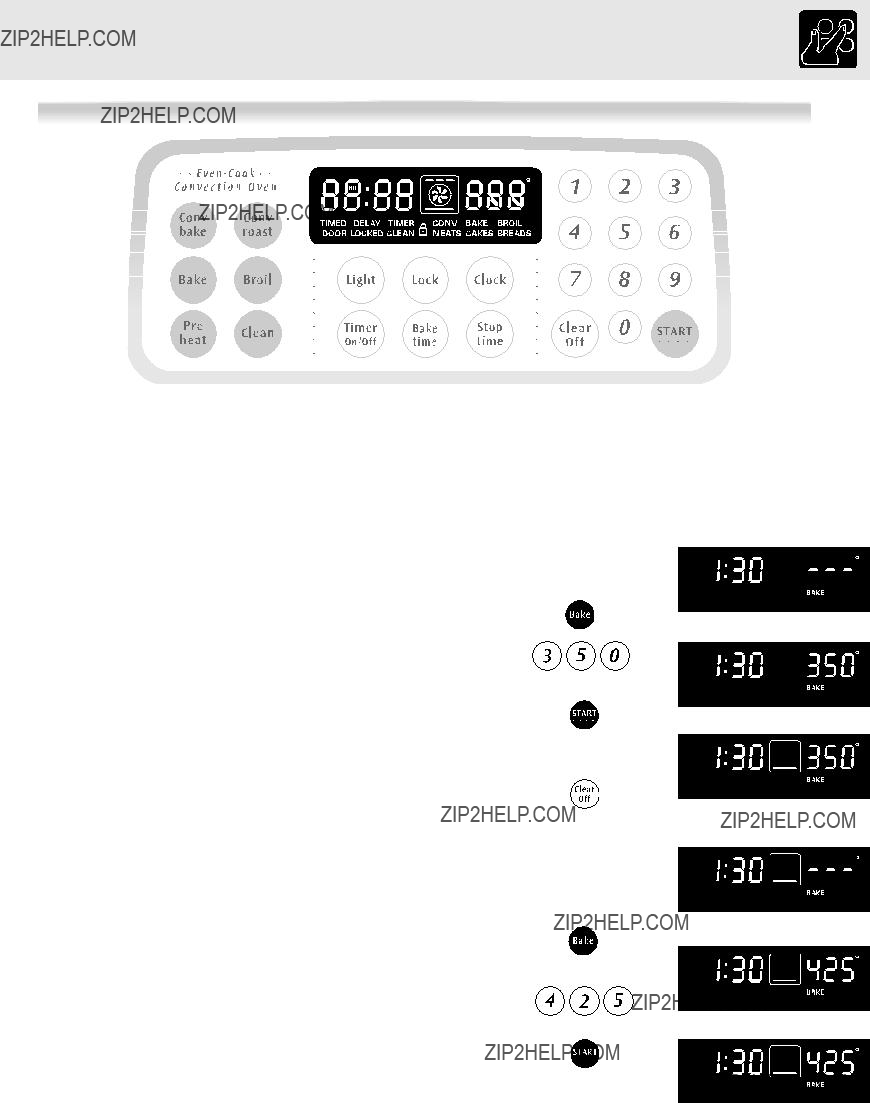
Setting Oven Controls
Setting Bake
The BAKE  pad controls normal baking. If preheating is necessary, refer to the
pad controls normal baking. If preheating is necessary, refer to the  Preheat Feature for instructions. The oven can be programmed to bake at any temperature from 170??F to 550??F (The sample shown below is for 350??F).
Preheat Feature for instructions. The oven can be programmed to bake at any temperature from 170??F to 550??F (The sample shown below is for 350??F).
To set the Bake Temperature to 350??F:
1.Arrange interior oven racks and place food in oven.
2.Press  , "- - - ??" will appear in the display (Fig. 1).
, "- - - ??" will appear in the display (Fig. 1).
3.Press 

 (Fig. 2). "BAKE" will flash and "350??" will appear in the display.
(Fig. 2). "BAKE" will flash and "350??" will appear in the display.
4.Press  . "BAKE" and "350??" will appear in the display (See
. "BAKE" and "350??" will appear in the display (See
Fig. 3).
Note: A beep will sound once the oven temperature reaches 350?? F. Pressing  will cancel the Bake feature at any time.
will cancel the Bake feature at any time.
Figure 1
Figure 2
Figure 3
To change the Bake Temperature (example changing from 350?? to 425??F):
1.After the oven has already been set to bake at 350??F and the
oven temperature needs to be changed to 425??F, press  (Fig.4) and "- - - ?? " will show in the display.
(Fig.4) and "- - - ?? " will show in the display.
2.Press 

 (Fig. 5). "425??" and "BAKE" will appear in the display.
(Fig. 5). "425??" and "BAKE" will appear in the display.
3.Press  . "BAKE" and the new oven temperature "425??" will appear in the display (Fig 6).
. "BAKE" and the new oven temperature "425??" will appear in the display (Fig 6).
Figure 4
Figure 5
Figure 6
19

Setting Oven Controls
Setting Timed Bake
The BAKE  and BAKE TIME
and BAKE TIME  pads control the Timed Bake feature. The automatic timer of the Timed Baked feature will turn the oven off at the time you select in advance.
pads control the Timed Bake feature. The automatic timer of the Timed Baked feature will turn the oven off at the time you select in advance.
3.Press  , "- - - ??" will appear in the display (Fig. 1).
, "- - - ??" will appear in the display (Fig. 1).
4.Press 

 (Fig. 2). "BAKE" will flash and "350??" will appear in the display.
(Fig. 2). "BAKE" will flash and "350??" will appear in the display.
5.Press  . "BAKE" and "350??" will be displayed (See Fig. 3).
. "BAKE" and "350??" will be displayed (See Fig. 3).
6.Press  . "TIMED" will flash; "BAKE", "0:00" and "350??" will appear in the display (Fig.4).
. "TIMED" will flash; "BAKE", "0:00" and "350??" will appear in the display (Fig.4).
7.Enter the desired baking time by pressing 
 . "TIMED" will flash and "BAKE", ":50" and "350??" will appear in the display (Fig. 5). Note: Baking time can be set for any amount of time between 1 minute to 11 hours and 59 minutes.
. "TIMED" will flash and "BAKE", ":50" and "350??" will appear in the display (Fig. 5). Note: Baking time can be set for any amount of time between 1 minute to 11 hours and 59 minutes.
8.Press  . Both the "TIMED" and "BAKE" icons will remain on in the display (Fig. 6). Once the Timed Bake feature has started, the current time of day will appear in the display.
. Both the "TIMED" and "BAKE" icons will remain on in the display (Fig. 6). Once the Timed Bake feature has started, the current time of day will appear in the display.
Note: After the Timed Bake feature has activated, press  to
to
display the bake time remaining in the Timed Bake mode. Once Timed Bake has started baking, a beep will sound when the oven
temperature reaches the set temperature. The BAKE TIME  pad may also be used to set timed or delayed timed cooking with
pad may also be used to set timed or delayed timed cooking with
the CONV ROAST or CONV BAKE
or CONV BAKE  pads.
pads.
Press  when baking is complete or at any time to cancel the Timed Bake feature.
when baking is complete or at any time to cancel the Timed Bake feature.
When the timed bake time runs out:
1."End" will appear in the display and the oven will shut off automatically (Fig. 7).
2.The control will beep 4 times. The control will continue to beep 3 times each minute until  is pressed.
is pressed.
Figure 2
Figure 3
Figure 4
Figure 5
Figure 6
Figure 7
 Use caution with the TIMED BAKE or DELAYED TIME BAKE features. Use the automatic timer when cooking cured or frozen meats and most fruits and vegetables. Foods that can easily spoil such as milk, eggs, fish, meat or poultry, should be chilled in the refrigerator first. Even when chilled, they should not stand in the oven for more than 1 hour before cooking begins, and should be removed promptly when cooking is completed. Eating spoiled food can result in
Use caution with the TIMED BAKE or DELAYED TIME BAKE features. Use the automatic timer when cooking cured or frozen meats and most fruits and vegetables. Foods that can easily spoil such as milk, eggs, fish, meat or poultry, should be chilled in the refrigerator first. Even when chilled, they should not stand in the oven for more than 1 hour before cooking begins, and should be removed promptly when cooking is completed. Eating spoiled food can result in
sickness from food poisoning.
20

Setting Oven Controls
Setting Delayed Time Bake
The BAKE  , BAKE TIME
, BAKE TIME  and STOP TIME
and STOP TIME  pads control the Delayed Time Bake feature. The automatic timer of the Delayed Time Bake will turn the oven on and off at the time you select in advance.
pads control the Delayed Time Bake feature. The automatic timer of the Delayed Time Bake will turn the oven on and off at the time you select in advance.
To program the oven for a delayed bake start time and to shut off automatically (example for baking at 350??F for 50 minutes and finishing at 5:30):
1.Be sure that the clock is set with the correct time of day.
2.Arrange interior oven rack(s) and place the food in the oven.
3.Press  . "- -
. "- -
4.Press 

 (Fig. 2). "BAKE" will flash and "350??" will appear in the display.
(Fig. 2). "BAKE" will flash and "350??" will appear in the display.
5.Press  . "BAKE" and "350??" will appear in the display (Fig. 3).
. "BAKE" and "350??" will appear in the display (Fig. 3).
6.Press  . "TIMED" will flash; "BAKE", "0:00" and "350??" will appear in the display (Fig.4).
. "TIMED" will flash; "BAKE", "0:00" and "350??" will appear in the display (Fig.4).
7.Enter the desired baking time using the number pads by pressing

 . "TIMED" will flash; "BAKE", ":50" and "350??" will appear in the display (Fig. 5). Note: Baking time can be set for any amount of time from 1 minute to 11 hours and 59 minutes.
. "TIMED" will flash; "BAKE", ":50" and "350??" will appear in the display (Fig. 5). Note: Baking time can be set for any amount of time from 1 minute to 11 hours and 59 minutes.
8 Press  . "TIMED", "BAKE" and "350??" will be displayed (Fig. 6).
. "TIMED", "BAKE" and "350??" will be displayed (Fig. 6).
9.Press  . Enter the desired stop time using the number pads
. Enter the desired stop time using the number pads


 (Fig. 7).
(Fig. 7).
10.Press  . When Delayed Time Bake starts, the set oven temperature will disappear, "TIMED DELAY", "BAKE" and the current time of time of day will appear in the display (Fig. 8).
. When Delayed Time Bake starts, the set oven temperature will disappear, "TIMED DELAY", "BAKE" and the current time of time of day will appear in the display (Fig. 8).
Note: Once Delayed Time Bake has started, press  to display the
to display the
bake time remaining . Once Delayed Time Bake has started baking, a beep will sound when the oven temperature reaches the set
temperature. Press  when baking has completed or at any time to cancel the Delayed Time Bake feature.
when baking has completed or at any time to cancel the Delayed Time Bake feature.
When the set bake time runs out:
1."End" will appear in the display and the oven will shut off automatically (Fig. 9).
2.The control will beep 4 times. The control will continue to beep 3 times each minute until  is pressed.
is pressed.
Figure 1
Figure 2
Figure 3
Figure 4
Figure 5
Figure 6
Figure 7
Figure 8
Figure 9
21

Setting Oven Controls
Setting Broil (for Gas Ranges) - The pad controls the Broil feature. When broiling, heat radiates downward
pad controls the Broil feature. When broiling, heat radiates downward
from the oven burner broiler for even coverage. The Broil feature is preset to start broiling at 550??F however, the Broil feature temperature may be set between 400??F and 550??F.
The broil pan and broil pan insert used together allow dripping grease to drain and be kept away from the high heat of the oven broiler. DO NOT use the broil pan without the insert (See Fig. 4). DO NOT cover the broil pan insert with foil. The exposed grease could catch fire.
 Should an oven fire occur, leave the oven door closed and turn off the oven. If the fire continues, throw baking soda on the fire or use a fire extinguisher. DO NOT put water or flour on the fire. Flour may be explosive and water can cause a grease fire to spread and cause personal injury.
Should an oven fire occur, leave the oven door closed and turn off the oven. If the fire continues, throw baking soda on the fire or use a fire extinguisher. DO NOT put water or flour on the fire. Flour may be explosive and water can cause a grease fire to spread and cause personal injury.
To set the oven to broil at the default setting (550??F):
1.Place the broiler pan insert on the broiler pan. Then place the food on the broiler pan insert. DO NOT use the broiler pan without the insert. DO NOT cover the broiler insert with foil. The exposed grease could ignite.
2.Arrange the interior oven rack and place the broiler pan on the rack. Be sure to center the broiler pan directly under the broiler burner. Close the oven door.
3.Press 
 . "BROIL" will flash and "550??" will appear (Fig. 1).
. "BROIL" will flash and "550??" will appear (Fig. 1).
4.If a lower broil temperature is desired (minimum broil temperature setting is 400??F), press the desired temperature before continuing to step 5.
5.Press
 . The oven will begin to broil. "BROIL" and "550??" will appear in the display (Fig. 2).
. The oven will begin to broil. "BROIL" and "550??" will appear in the display (Fig. 2).
6.Broil on one side until food is browned; turn and cook on the second side. Season and serve. Note: Always pull the rack out to the stop position before turning or removing food.
7.To cancel broiling or if finished broiling press  (Fig. 3).
(Fig. 3).
Figure 1
Figure 2
Figure 3
Broiling Times
Use the following table for approximate broiling times. Increase or decrease broiling times, or move the broiling pan to a different rack position to suit for doneness. If the food you are broiling is not listed in the table, follow the instructions provided in your cookbook and watch the item closely.

Setting Oven Controls
Setting Convection Roast
The CONV ROAST  pad feature is used when cooking with meat. This pad has been designed to give optimum cook performance for roasting meats.
pad feature is used when cooking with meat. This pad has been designed to give optimum cook performance for roasting meats.
The CONVECTION ROAST pad combines a cook cycle with the convection fan and element to roast meats and poultry. Preheating is not necessary for meats and poultry. Heated air circulates around the food from all sides, sealing in juices and flavors. Foods are crispy brown on the outside while staying moist on the inside.
To set the Convection Roast feature (example for
Convection Roast at 350??F):
1. Arrange interior oven racks and place food in oven.
2. Press  . "CONV" will flash and
. "CONV" will flash and
3. Press 

 . "CONV" will flash and "350??" will appear in the display (See Fig. 2).
. "CONV" will flash and "350??" will appear in the display (See Fig. 2).
4. Press  . "CONV" and "350??" will appear in the display (See
. "CONV" and "350??" will appear in the display (See
Fig. 3). The convection fan icon will come on a few minutes after setting the Convection Roast feature (See Fig. 4).
Press  to stop Convection Roast, or to cancel Convection Roast at any time.
to stop Convection Roast, or to cancel Convection Roast at any time.
Convection Roasting Instructions
When using the Convection Roast pad, use the broiler pan and insert along with the roasting rack. The broiler pan will catch grease spills and the insert will help prevent grease spatters. The roasting rack will allow the heat to circulate around the meat.
 To prevent food from contacting the broil element and to prevent grease spattering, DO NOT use the roasting rack when broiling.
To prevent food from contacting the broil element and to prevent grease spattering, DO NOT use the roasting rack when broiling.
1.Place oven rack on bottom or next to the bottom rack position. See Arranging Oven Racks in this Use & Care Manual.
2.Place the insert in the broiler pan. The roasting rack fits on the insert allowing the heated air to circulate under the food for even cooking and helps to increase browning on the underside. Make sure the roasting rack is securely seated on the insert in the broiler pan . DO NOT use the broiler pan without the insert or cover the insert with aluminum foil.
3.Position food (fat side up) on the roasting rack (See Fig. 4).
4.Place the broiler pan on the oven rack.
Note: The BAKE TIME  pad may be used to set timed or delayed timed cooking with the CONV ROAST
pad may be used to set timed or delayed timed cooking with the CONV ROAST  pad (refer to page 20, steps
pad (refer to page 20, steps
DISPLAY
Figure 1
Figure 2
Figure 3
Figure 4
Figure 4
23
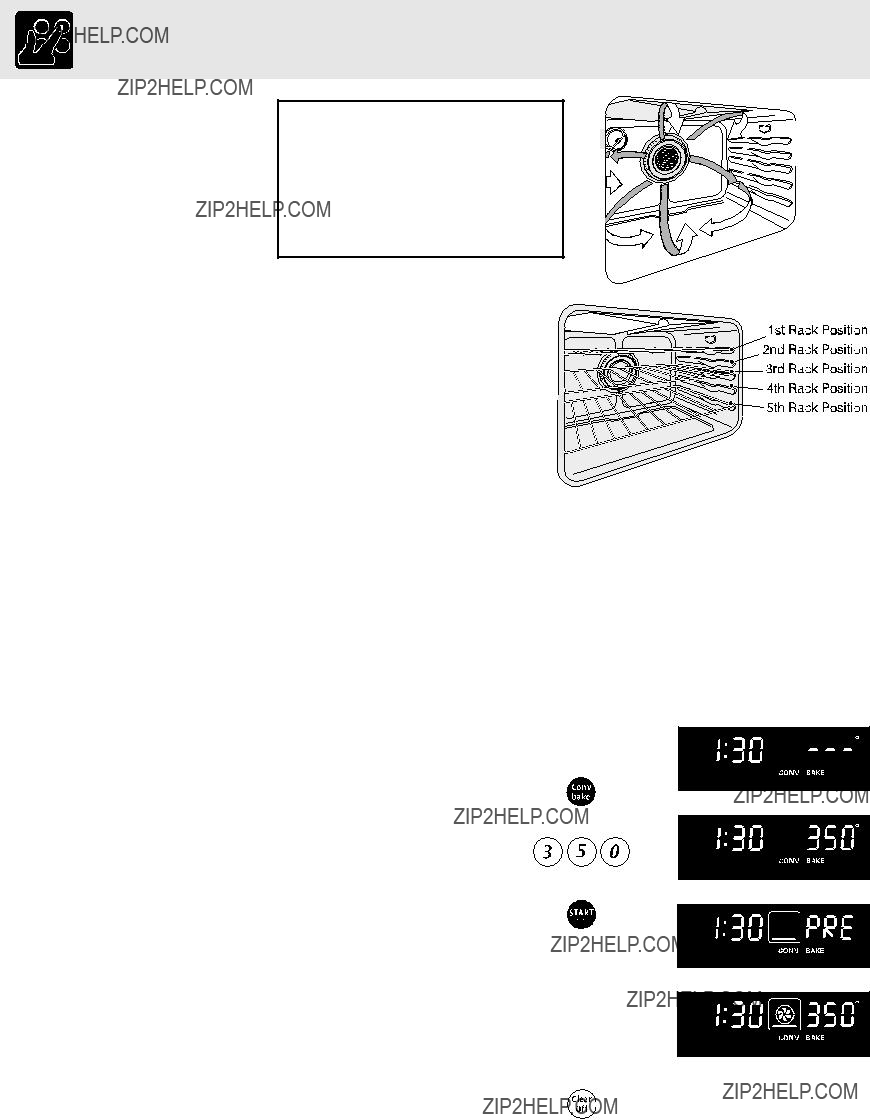
Setting Oven Controls
Setting Convection Bake
The CONV BAKE  pad controls
pad controls
the Convection Bake feature. Use the Convection Bake feature when cooking speed is desired. The oven can be programmed for Convection baking at any temperature between 300??F (149?? C) to 550??F (288?? C).
Benefits of Convection Bake:
Air circulation during Convection Bake
Convection baking uses a fan to circulate the oven's heat evenly and continuously within the oven (See Figure 1). This improved heat distribution allows for fast, even cooking and browning results. It also gives better baking results when using two (2) or three (3) racks at the same time. Breads and pastries brown more evenly. Most foods cooked in a standard oven will cook faster and more evenly with Convection Bake.
Note: The BAKE TIME  pad may be used to set timed or delayed timed cooking with the CONV BAKE
pad may be used to set timed or delayed timed cooking with the CONV BAKE  pad (refer to page 20 steps
pad (refer to page 20 steps
Figure 1
Figure 2
General Convection Bake Instructions
1.When using Convection Bake, decrease your normal cooking times as shown on page 34. Adjust the cook time for desired doneness as needed. Time reductions will vary depending on the amount and type of food to be cooked. Cookies and biscuits should be baked on pans with no sides or very low sides to allow heated air to circulate around the food. Food baked on pans with a dark finish will cook faster.
2.Preheating is not necessary when cooking casseroles with Convection Bake.
3.When using Convection Bake with a single rack, place oven rack in position 3 or 4. If cooking on multiple racks, place the oven racks in positions 1, 3 and 5 (for 3 racks) and positions 2 and 4 (for 2 racks; See Fig. 2).
4.Layer cakes will have better results when baked with the normal Bake feature.
To set the oven for Convection Bake and temperature to 350??F:
1. Arrange interior oven racks and place food in oven.
2. Press  . "CONV BAKE" will flash and "- -
. "CONV BAKE" will flash and "- -
Figure 3
the display (Fig. 3).
3. Press 

 . "CONV BAKE" and "350??"will appear in the display.
. "CONV BAKE" and "350??"will appear in the display.
Figure 4
4.Press . "CONV BAKE" and "PRE" will appear in the display (Fig. 5) until the oven reaches 350??F. A beep will sound once the oven temperature reaches 350??F and the display will show "350??", "CONV BAKE" and the fan icon (Fig. 6).
. "CONV BAKE" and "PRE" will appear in the display (Fig. 5) until the oven reaches 350??F. A beep will sound once the oven temperature reaches 350??F and the display will show "350??", "CONV BAKE" and the fan icon (Fig. 6).
Note: The convection fan will come on a short time AFTER the oven has been set for Convection Bake. The oven icon display will then show a rotating fan. This rotating fan icon indicates when the Convection Fan is operating (See Fig. 6).
Press  to stop Convection Bake or cancel Convection Bake at any time.
to stop Convection Bake or cancel Convection Bake at any time.
Figure 5
Figure 6
24

 The health of some birds is extremely sensitive to the fumes given off during the self- cleaning cycle of any range. Move birds to another
The health of some birds is extremely sensitive to the fumes given off during the self- cleaning cycle of any range. Move birds to another
Figure 1
Preparing for the
A
1.Adhere to the following cleaning precautions:
???Allow the oven to cool before
???Wear rubber gloves when precleaning and while wiping up the residue after the self- clean cycle.
???DO NOT use oven cleaners or oven protective coatings in or around any part of the
???DO NOT clean the oven door gasket. The woven material of the oven door gasket is essential for a good seal. Care should be taken not to rub, damage or remove the gasket.
???DO NOT use any cleaning materials on the oven door gasket. Doing so could cause damage.
2.Remove the searing grill, broiler pan and broiler pan insert, all utensils and any aluminum foil. These items cannot withstand high cleaning temperatures.
 DO NOT line the oven walls, racks, bottom or any other part of the range with aluminum foil. Doing so will destroy heat distribution, produce poor baking results and cause permanent damage to the oven interior (aluminum foil will melt to the interior surface of the oven).
DO NOT line the oven walls, racks, bottom or any other part of the range with aluminum foil. Doing so will destroy heat distribution, produce poor baking results and cause permanent damage to the oven interior (aluminum foil will melt to the interior surface of the oven).
3.Oven racks should be removed, or else their finish will dull and their color turn slightly blue. If they do go through the
4.Remove any excess spillovers in the oven cavity before starting the
5.Clean any soil from the oven frame, the door liner outside the oven door gasket, and the small area at the front center of the oven bottom. These areas heat sufficiently to burn soil on. Clean with soap and water.
If at any time when setting the oven for the
NOTE: Prior to setting the
25

To Start
The CLEAN  pad controls the
pad controls the
cycle remember to allow time for the oven to cool down and the oven door to unlock. This normally takes about one hour. So to
*It is recommend to use a 2 hour
 During the
During the
 DO NOT force the oven door open. This can damage the automatic door locking system. Use care when opening the oven door after the
DO NOT force the oven door open. This can damage the automatic door locking system. Use care when opening the oven door after the
To set the controls for a 3 hour
1.Be sure the clock is set with the correct time of day and the oven door is closed.
2.Press  . "CLEAN" will flash and "3:00" will show in the display (Fig. 1). The control will automatically clean for a 3 hour period (default
. "CLEAN" will flash and "3:00" will show in the display (Fig. 1). The control will automatically clean for a 3 hour period (default
clean time is desired, press  for 2 hour or press
for 2 hour or press  for a 4 hour clean time. Set the cleaning time based on the amount of soil you have; light, medium or heavy (*See above).
for a 4 hour clean time. Set the cleaning time based on the amount of soil you have; light, medium or heavy (*See above).
3.Press  .The "DOOR LOCKED" icon will flash; "CLEAN" icon and the letters "CLn" will remain on in the display (Fig. 2).
.The "DOOR LOCKED" icon will flash; "CLEAN" icon and the letters "CLn" will remain on in the display (Fig. 2).
4.As soon as the control is set, the motor driven oven door lock will begin to close automatically. Once the door has been locked the "DOOR LOCKED" indicator light will stop flashing and remain on. Also, the oven icon will appear in the display (Fig. 3).
Note: Allow about 15 seconds for the oven door lock to close.
When the
1.The time of day, the "DOOR LOCKED" and "CLEAN" icon will remain in the display (Fig. 4).
2.Once the oven has cooled down for approximately 1 HOUR, and the "DOOR LOCKED" icon is no longer displayed, the oven door can then be opened (Fig. 5).
Stopping or Interrupting a
If it becomes necessary to stop or interrupt a
1.Press  .
.
2.Once the oven has cooled down for approximately 1 HOUR and the "DOOR LOCKED" icon is no longer displayed,the oven door can then be opened (Fig. 5).
Figure 3
Figure 4
Figure 5
26
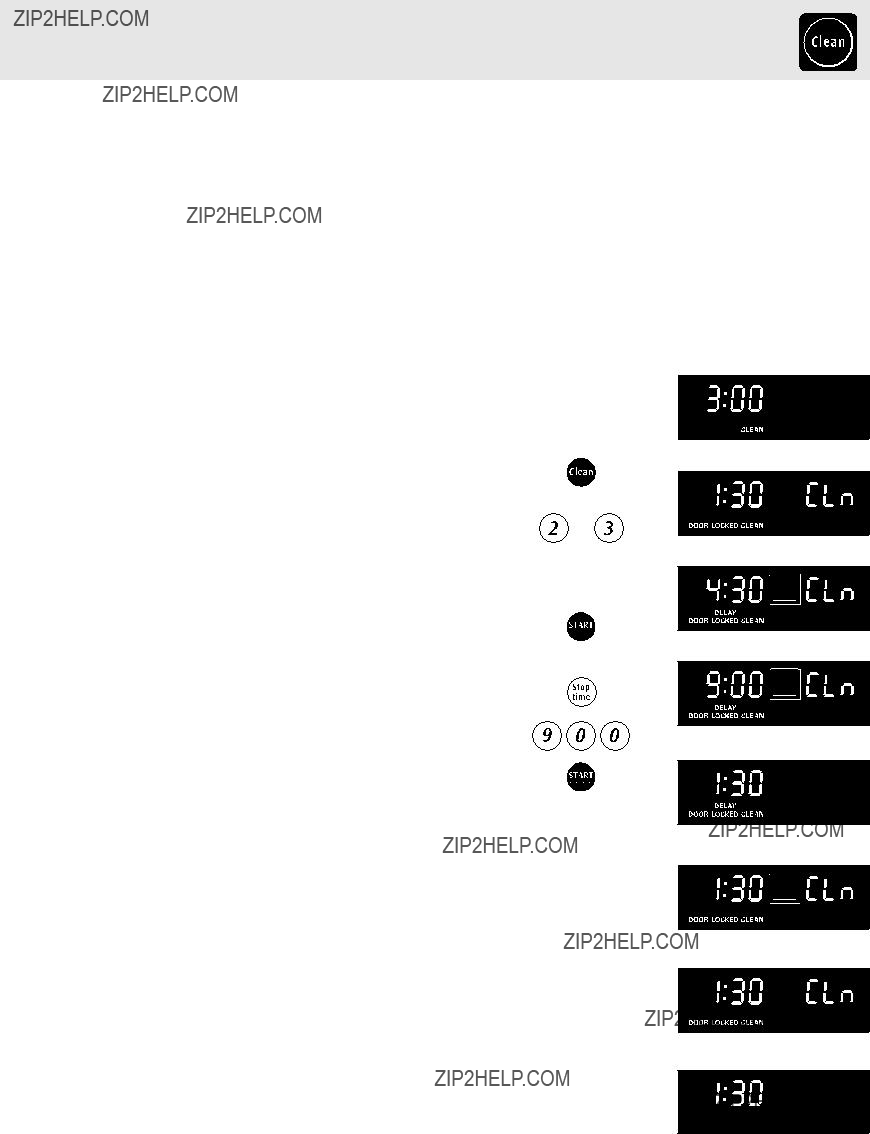
To Start Delayed
The CLEAN  , STOP TIME
, STOP TIME  pads and length of clean cycle, controls the Delayed
pads and length of clean cycle, controls the Delayed
automatic timer will turn the oven on and off at the time you select in advance. Be sure to review TO START THE SELF- CLEAN CYCLE for recommended clean times.
 During the
During the
 DO NOT force the oven door open. This can damage the automatic door locking system. Use care when opening the oven door after the
DO NOT force the oven door open. This can damage the automatic door locking system. Use care when opening the oven door after the
INSTRUCTIONS
To set the control for the
1.Be sure the clock is set with the correct time of day and the oven door is closed.
2.Press  . "CLEAN" will flash and "3:00" will show in the display (Fig. 1). The control will automatically clean for a 3 hour period (default
. "CLEAN" will flash and "3:00" will show in the display (Fig. 1). The control will automatically clean for a 3 hour period (default
clean time is desired, press  for 2 hour or press
for 2 hour or press  for a 4 hour clean time. Set the cleaning time based on the amount of soil you have; light, medium or heavy (*See page 26).
for a 4 hour clean time. Set the cleaning time based on the amount of soil you have; light, medium or heavy (*See page 26).
3.Press  .The "DOOR LOCKED" icon will flash; "CLEAN" icon and the letters "CLn" will remain on in the display (Fig. 2).
.The "DOOR LOCKED" icon will flash; "CLEAN" icon and the letters "CLn" will remain on in the display (Fig. 2).
4.Press  (Fig. 3). Enter the desired stop time using the number pads
(Fig. 3). Enter the desired stop time using the number pads 

 (Fig. 4).
(Fig. 4).
5.Press  . The "CLn" icon will turn off; "DELAY", "DOOR LOCKED" and "CLEAN" icons will remain on.
. The "CLn" icon will turn off; "DELAY", "DOOR LOCKED" and "CLEAN" icons will remain on.
6.As soon as the control is set, the motor driven oven door lock will begin to close automatically and once the door has been locked the "DOOR LOCKED" indicator light will quit flashing and remain on. The oven icon will appear in the display (Fig. 5).
7.The control will calculate backward from the set stop time to determine when the
When the
1.The time of day, the "DOOR LOCKED" and "CLEAN" icon will remain in the display (Fig. 7).
2.Once the oven has cooled down for approximately 1 HOUR, and the "DOOR LOCKED" icon is no longer displayed, the oven door can then be opened (Fig. 8).
PRESSDISPLAY
Figure 1
or
Figure 2
or 
Figure 3
Figure 4
Figure 5
Figure 6
Figure 7
Figure 8
27

Adjusting Oven Temperature
The temperature in the oven has been
Note: The oven temperature adjustments made with this feature will not change the
To adjust the oven temperature higher:
1. Press  for 6 seconds (Fig. 1).
for 6 seconds (Fig. 1).
2. To increase the temperature use the number pads to enter the
temperature may be increased as much as 35??F (17??C).
will return to the time of day (Fig. 3). Press  to reject the
to reject the
change if necessary.
Figure 3
To adjust the oven temperature lower:
1.Press  for 6 seconds (Fig. 4).
for 6 seconds (Fig. 4).
2.To decrease the temperature use the number pads to enter the
desired change. (Example 
 and then press
and then press
 (Fig. 5). The temperature may be decreased as much as 35??F (17??C).
(Fig. 5). The temperature may be decreased as much as 35??F (17??C).
3.Press  to accept the temperature change and the display will return to the time of day (Fig. 6). Press
to accept the temperature change and the display will return to the time of day (Fig. 6). Press  to reject the
to reject the
change if necessary.
Figure 4
Figure 5
Figure 6
28

Painted and Plastic
Control Knobs, Body
Parts, and Decorative
Trim
For general cleaning, use hot, soapy water and a cloth. For more difficult soils and
Before cleaning the control panel, turn all controls to OFF and remove the control knobs. To remove, pull each knob straight off the shaft. Clean using hot, soapy water and a dishcloth. Rinse with a clean water using a dishcloth. Be sure to squeeze excess water from the cloth before wiping the panel; especially when wiping around the controls. Excess water in or around the controls may cause damage to the appliance.To replace knobs after cleaning, line up the flat sides of both the knob and the shaft; then push the knob into place.
Stainless Steel, Chrome
Control Panel, Decorative
Trim
Clean stainless steel with hot, soapy water and a dishcloth. Rinse with clean water and a cloth. Do not use cleaners with high concentrations of chlorides or chlorines. Do not use harsh scrubbing cleaners. Only use kitchen cleaners that are especially made for cleaning stainless steel. Always be sure to rinse the cleaners from the surface as bluish stains may occur during heating that cannot be removed.
Porcelain Enamel Broiler Pan and Insert, Door Liner, Body Parts, Warmer Drawer (for Burner Caps, Burner Heads and Grates see page 30).
Gentle scouring with a soapy scouring pad will remove most spots. Rinse with a 1:1 solution of clear water and ammonia. If necessary, cover difficult spots with an ammonia- soaked paper towel for 30 to 40 minutes. Rinse with clean water and a damp cloth, and then scrub with a
If the racks are cleaned in the
DO NOT clean the oven door gasket. The oven door gasket is made of a woven material, on self cleaning models, which is essential for a good seal. Care should be taken not to rub, damage or remove the gasket.
29
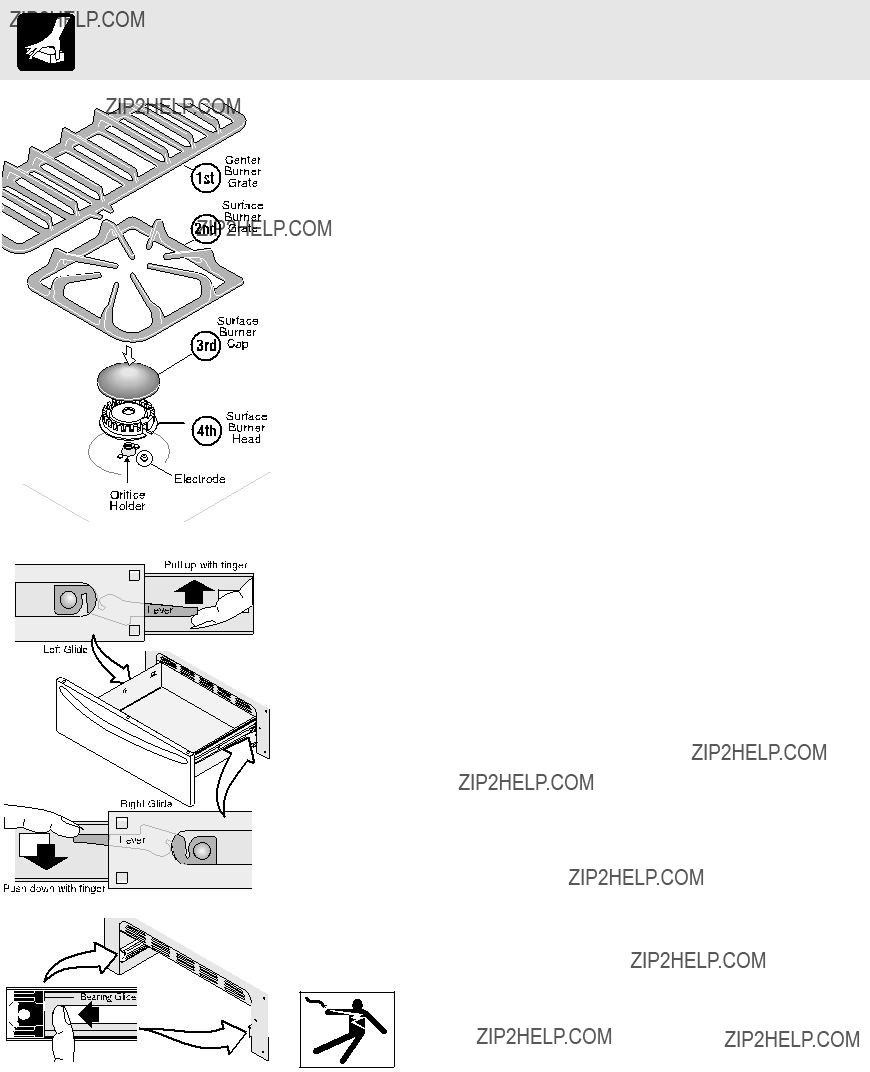
Care & Cleaning
Figure 1
Cleaning the Burner Grates, Burner Caps and Burner Heads
The Burner Grates, Burner Caps and Burner Heads should be routinely cleaned. Keeping the burner ports clean will prevent improper ignition and an uneven flame at each burner position. Refer to the following instructions.
To Remove and Replace the Surface Burner Grate, Surface Burner Cap and Surface Burner Head - Remove in the following order; (1st) Center Burner Grate, (2nd) Surface Burner Grate, (3rd) Surface Burner Cap, (4th) Surface Burner Head (See Fig. 1).
Reverse the procedure above to replace the Surface Burner Cap, Surface Burner Head and Surface Burner Grate. Do not remove any burner parts from the cooktop until the burner parts have completely cooled and are safe to handle. Do not operate the surface burners without the Surface Burner Caps, Surface Burner Heads and Surface Burner Grates properly in place.
To Clean the Burner Caps, Burner Heads and Burner Grates - Use a
OTHER MATERIAL TO ENTER THE GAS ORIFICE HOLDER OPENING. ALWAYS keep the surface burner cap and surface burner head in place whenever a surface burner is in use.
Removing and Replacing the Warming Drawer (some models)
To Remove Warming Drawer:
1. Turn power off before removing the warmer drawer.
Turn power off before removing the warmer drawer.
2.Open the drawer to the fully opened position.
3.Locate glide lever on each side of drawer, pull up on the left glide lever and
push down on the right glide lever (See Fig. 2). 5. Pull the Warming Drawer away from the range.
To Replace Warming Drawer:
1. Pull the bearing glides to the front of the chassis glide (See Fig. 3).
2. Align the glide on each side of the drawer with the glide slots on the range. 3. Push the drawer into the range until levers ???click??? (approximately 2???). Pull the drawer open again to seat bearing glides into position. If you do not hear the
Figure 2
levers ???click??? or the bearing glides do not feel seated remove the drawer
and repeat steps 1 thru 3. This will minimize possible damage to the bearing glides.
NOTE: The Warming Drawer will NOT operate while in the
 Electrical Shock Hazard can occur and result in serious injury or death. Disconnect appliance from electric power before cleaning and servicing the warmer drawer.
Electrical Shock Hazard can occur and result in serious injury or death. Disconnect appliance from electric power before cleaning and servicing the warmer drawer.
Care & Cleaning of Stainless Steel (some models)
Some models are equipped with stainless steel exterior parts. Special care and cleaning are required for maintaining the appearance of stainless parts. Please refer to the Cleaning Chart provided at the beginning of the Care & Cleaning section in this Use & Care Manual.
30
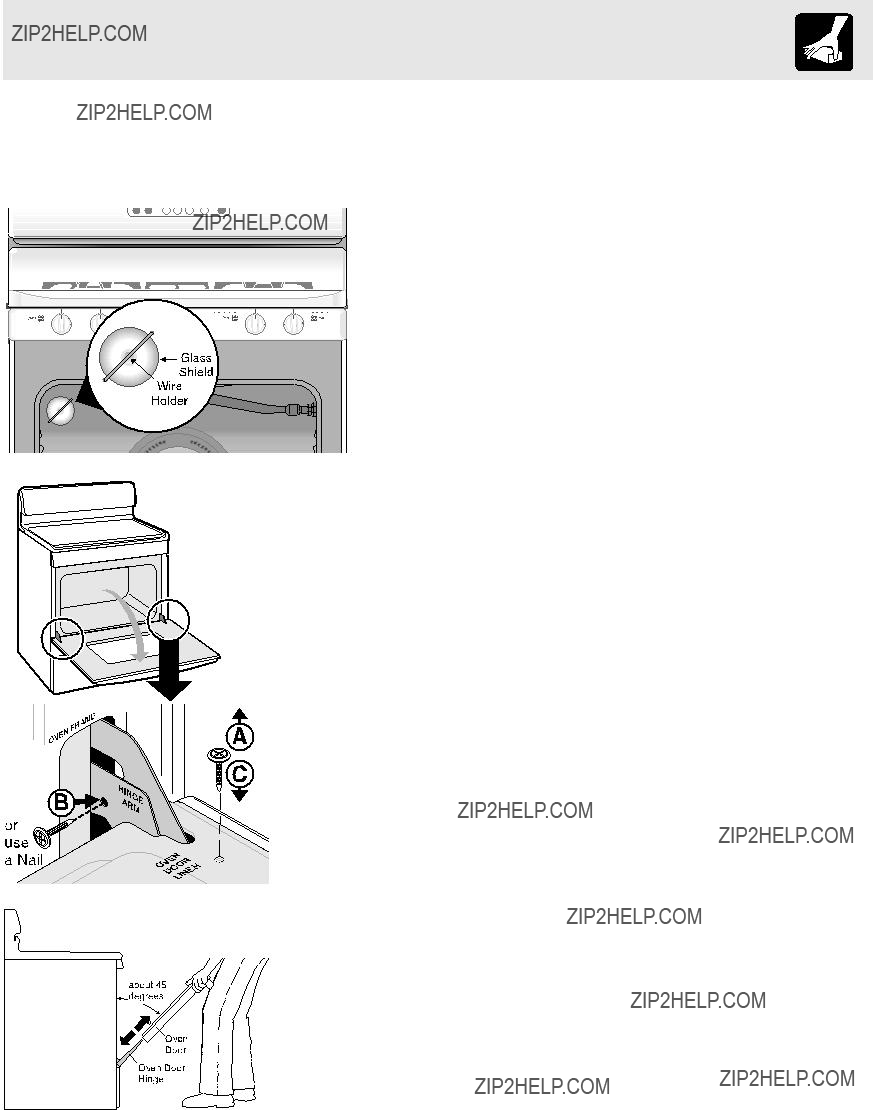
Care & Cleaning
Operating and Replacing the Oven Light
The interior oven light will The oven interior light will automatically turn on when the oven door is opened. Press  to turn
to turn
the light ON and OFF when the oven door is closed. The oven light is located at the rear wall of the oven interior and is covered with a glass shield held by a wire holder. The glass shield must be in place whenever the oven is in use.
Figure 1
Figure 2
Figure 3
Figure 4
 Be sure the range is unplugged and all parts are COOL before replacing the oven light. Wear a
Be sure the range is unplugged and all parts are COOL before replacing the oven light. Wear a
To Replace the Oven Light:
1. Turn electrical power off at the main source and unplug the range. 2. Press wire holder to one side to release glass shield (See Fig. 1). 3. Replace the old bulb with a new 40 watt appliance bulb.
4.Replace glass shield over bulb and snap wire holder into place.
5.Turn power back on again at the main source (or plug in the range).
6. The clock will then need to be reset. To reset, see Setting the Clock in this Use & Care Manual.
Removing and Replacing the Oven Door (all models)
 The door is heavy. For safe, temporary storage, lay the door flat with the inside of the door facing down.
The door is heavy. For safe, temporary storage, lay the door flat with the inside of the door facing down.
To Remove Oven Door:
1.Open oven door completely (horizontal with floor - See Fig. 2).
2.Remove 2 screws located on the inside of the oven door liner (See A Fig. 3).
3.Insert the 2 screws into the door hinge holes located on the side of the hinge arm, one into each hinge (See B Fig. 3).
4.Close oven door until the door stops, (Do not force the door to close any further). The placement of these screws should keep door open in about a 45 degree position.
5.Grasp oven door firmly on both sides and slide door up and off hinges at the same angle. (See Fig. 4)
6.To clean oven door, follow the instructions provided in the Cleaning Chart at the
beginning of the Care & Cleaning section (See Door Liner).
To Replace Oven Door:
1. Be sure the hinge arms remain at the 45 degree angle position. Be sure the screws are still locking the hinge arms from moving. If the screws fall out of the hinge holes, the hinge(s) may snap back against the oven frame and could pinch fingers or chip the porcelain finish on the oven front frame.
2.Hold door at the sides near the top while resting the lower front of door on your knee. Insert the door channels at the bottom of door over the door hinges, (See
Fig. 4).
3. Allow the door to slide down into the door hinges evenly at the same 45 degree angle. The hinge arms should be inserted into the bottom corners as far as they can go.
4. Open door completely (horizontal with floor) and remove both screws from holes in door hinges.
5. Reinstall the 2 screws into the door liner (See C Fig. 3).
6. If the door is not in alignment with the oven frame, remove door and repeat the above steps.
31

Before You Call
Solutions to Common Problems
Before you call for service, review this list. It may save you time and expense. The list includes common occurrences that are not the result of defective workmanship or materials in this appliance.
32

33

Cooking Tables
For Convection Cooking & Roasting
Foods for  CONVECTION BAKE pad
CONVECTION BAKE pad
*Decrease normal cook time by:
Begin with the maximum reduction in cook times and adjust as needed.
*Recommended reduction in cook times based on brands of food items tested. Cook times may vary with your specific brand of food item.
Foods for  CONVECTION ROAST pad
CONVECTION ROAST pad
*Decrease
normal cook time by:
Begin with the maximum reduction in cook times and adjust as needed.
*Recommended reduction in cook times based on brands of food items tested. Cook times may vary with your specific brand of food item.
34

Notes
35

RANGE WARRANTY
Your range is protected by this warranty
In the U.S.A., your appliance is warranted by Electrolux Home Products North America, a division of White Consolidated Industries, Inc. We authorize no person to change or add to any of our obligations under this warranty. Our obligations for service and parts under this warranty must be performed by us or an authorized Electrolux Home Products North America servicer. In Canada, your appliance is warranted by WCI Canada, Inc.
*NORMAL
RESPONSIBILITIES
OF THE CONSUMER
EXCLUSIONS
IF YOU NEED
SERVICE
This warranty applies only to products in ordinary household use, and the consumer is responsible for the items listed below:
1.Proper use of the appliance in accordance with instructions provided with the product.
2.Proper installation by an authorized servicer in accordance with instructions provided with the appliance and in accordance with all local plumbing, electrical and/or gas codes.
3.Proper connection to a grounded power supply of sufficient voltage, replacement of blown fuses, repair of loose connections or defects in house wiring.
4.Expenses for making the appliance accessible for servicing, such as removal of trim, cupboards, shelves,etc., which are not a part of the appliance when it was shipped from the factory.
5.Damages to finish after installation.
6.Replacement of light bulbs and/or fluorescent tubes (on models with these features).
This warranty does not cover the following:
1.CONSEQUENTIAL OR INCIDENTAL DAMAGES SUCH AS PROPERTY DAMAGE AND INCIDENTAL EXPENSES
RESULTING FROM ANY BREACH OF THIS WRITTEN OR ANY IMPLIED WARRANTY.
NOTE: Some states do not allow the exclusion or limitation of incidental or consequential damages, so this limitation or exclusion may not apply to you.
2.Service calls which do not involve malfunction or defects in workmanship or material, or for appliances not in ordinary household use. The consumer shall pay for such service calls.
3.Damages caused by services performed by servicers other than Electrolux Home Products North America or its authorized servicers; use of parts other than genuine Electrolux Home Products parts; obtained from persons other than such servicers; or external causes such as abuse, misuse, inadequate power supply or acts of God.
4.Products with original serial numbers that have been removed or altered and cannot be readily determined.
Keep your bill of sale, delivery slip, or some other appropriate payment record. The date on the bill establishes the warranty period should service be required. If service is performed, it is in your best interest to obtain and keep all receipts. This written warranty gives you specific legal rights. You may also have other rights that vary from state to state. Service under this warranty must be obtained by contacting Electrolux Home Products:
This warranty only applies in the 50 states of the U.S.A., Puerto Rico, and Canada. Product features or specifications as described or illustrated are subject to change without notice. All warranties are made by Electrolux Home Products North America, a division of White Consolidated Industries, Inc. In Canada, your appliance is warranted by WCI Canada, Inc.
USA 800???944???9044
Electrolux Home Products North America
P.O. Box 212378
Augusta, GA 30917